Moose Mission in New York’s Adirondacks
Moose Mission
Story and photos by Julie Larsen Maher
special to mongabay.com
September 5, 2008
|
|
Bushwhacking our way through nearly impenetrable bogs and blow down in the central woods of the Adirondacks in northern New York, I am wondering…how can a MOOSE move through this stuff?
Weighing nearly 1400 pounds and standing six to seven feet tall, moose favor the dense mixed forests that surround the lakes and ponds of the Adirondacks, the largest publicly protected area in the contiguous United States. About 6 million acres of boreal forests, mountains, and lakes in northern New York are within the boundaries of the Adirondacks, half of which are public lands, the other half are private. The relatively cool climate and available plants on the many riparian banks of the area make for a moose mecca.
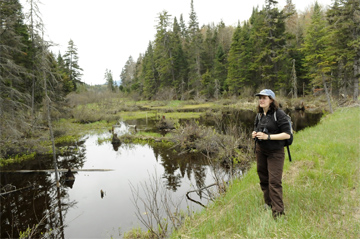 Conservationist Heidi Krester at the start of the transect in the Adirondacks known as Cherry Patch. Photo by Julie Larsen Maher ©WCS.  The WCS conservation team hikes the Cherry Patch transect. Photo by Julie Larsen Maher ©WCS. |
Hunting and logging caused moose numbers to slump to zero in the mid to late 1800's in the region, but over a hundred years later in the 1980's, reports of moose sightings caught the attention of conservation groups. The Wildlife Conservation Society (WCS) organized a moose mission to better understand the moose population.
I joined our team from the WCS North America Program's Adirondacks branch, led by conservationists Dr. Heidi Kretser and Dr. Michale Glennon.
"Moose are a symbol of the Northern Forest. Their return to the Adirondacks underscores the ability of the region to ‘rewild' itself after the unsustainable harvest and timber practices of the 1800s. However, with continued residential development on private lands and no natural predators, human-moose conflicts will likely escalate," says Kretser. "Understanding moose population dynamics—what they eat, and which habitats they use—will provide critical information for long-term management."
With the past in perspective and the future on their minds, the WCS group formed a plan around a novel approach for counting moose on a possible comeback.
Aptly named the AROMA project (Adirondack Return of Moose Assessment), WCS partnered with Working Dogs for Conservation (WCDF), a small group of wildlife professionals and their detection dogs that use a non-invasive method of surveying species, like moose, without ever seeing one. The WDCF dogs sniff out the moose scat (feces) from among the thick and thorny underbrush, and the team collects samples of the fecal findings to analyze for an array of information.
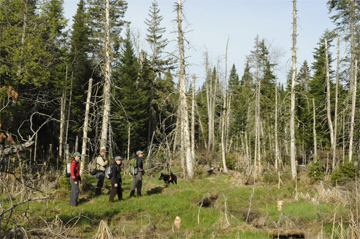 The WCS field team studies one of the many habitats in the Adirondacks where moose might call home, combined woods and water. Photo by Julie Larsen Maher ©WCS. 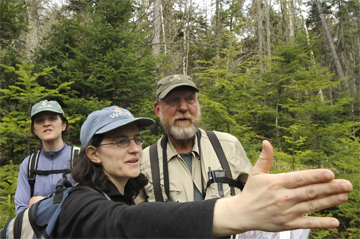 WCS field team Dr. Heidi Kretser and Zoe Smith work with orienteer Gary Lee on predetermined GPS coordinates through the Cherry Patch transect in the search for moose scat. Photo by Julie Larsen Maher ©WCS. |
Alice Whitelaw and Aimee Hurt of WDCF found the best dogs to train for this dirty job by identifying their focus for an object (a ball, for example) that becomes their reward for a job well done. After targeting a certain animal's scat from its scent, the dogs, Camas and Wicket, alert Whitelaw and Hurt, and then get their prize—a moment to "play ball." The transects then continue —20 in two weeks—all of which Kretser and Glennon have dubbed potential moose territory. The team and dogs find 140 moose samples in the tricky terrains, evidence that moose are definitely in our midst.
Thinking all transects in the Adirondacks must be a "walk in the park" due to the New York address, I load up all the camera gear I can into a single backpack for transect Cherry Patch. My bag is heavy and I feel like a turtle, my giant "shell" catching on every bending branch that I duck beneath. The dogs move quickly, often covering twice as much territory as their human handlers. I can barely keep up as Camas, the German shepherd, and Whitelaw, step lightly through the fiddlehead ferns at our feet. I sink into the bogs, and at one creek crossing, I fall in completely, ripping my pants in the process.
"Good girl," says Whitelaw, in a soothing voice.
It is not my spectacular fall she is acknowledging, but the discovery of another scat pile by Camas along a spot we have just passed by. The dog, with her amazing ability to detect scent, asked us to retrace our steps for a bit for one last collection on our way out of Cherry Patch.
I give Whitelaw a questioning look.
"The wind changed," says Whitelaw.
I cannot tell, even through the gaping hole in my pants. Camas detected the difference in the breeze immediately.
Cherry Patch is not a "walk in the park," but instead very wild habitat that includes all those that exist within the Adirondacks—unique forests and waters that are potential homes to many more than moose, including black bear and gray jays.
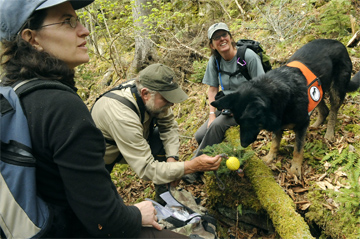 WCS field team Heidi Kretser, Gary Lee, and Alice Whitelaw give Camas her “play ball” moment, her reward for discovering a scat pile. Photo by Julie Larsen Maher ©WCS. 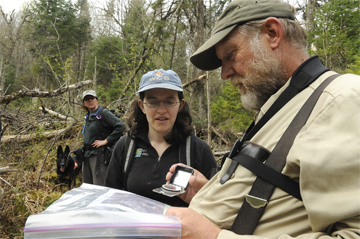 Orienteer Gary Lee and Heidi Kretser use a compass and transect map to continue through the bush of Cherry Patch. Alice Whitelaw and Camas await their directions. Photo by Julie Larsen Maher ©WCS. |
The steps to this type of wildlife census seem simple: train for scat, find the scat, and process the scat. In reality, each step has taken years to develop through careful science and training. Scat sampling and the information it contains can indeed prove that moose have returned to their native Adirondacks. The data from processing the samples can reveal how much space moose occupy, what they favor for food, and through further study of the DNA contained in each sample, even who is related to whom.
The processing begins soon after we have completed our five mile transect. Whitelaw, Hurt, Kretser, and Glennon set up plastic tubes, don gloves, and pile the packages of fresh poop high on the table, each labeled with a collection location. They take a small piece of scat from every bag and carefully place it in the tubes, preserving each one with ethanol (90 percent alcohol) for the next stop, which is the lab.
The scat samples from 140 venues are now preserved and currently awaiting genetic analyses. The WCS team hopes it will be soon. Glennon's bookshelves are filled with the tubes of poop in ethanol, and Kretser has jammed her basement freezer to capacity with the additional bags of collected scat which will be analyzed for moose nutrition and diet information.
A growing moose population in the Adirondacks leads to conservation concerns, among them how much area do they need and what is their ability to live alongside their human neighbors. Car collisions are one potential hazard of their comeback. People are not expecting moose on the roads, and the animals are so large that their eye shine is above the driver's line of sight. Issues like this one make community awareness of moose numbers a priority.
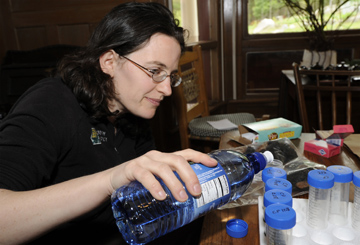 Heidi Kretser preserves the collected moose scat by placing it in labeled tubes and covering it with ethanol (90 percent alcohol). Photo by Julie Larsen Maher ©WCS. |
Conservationists are anticipating potential impacts to wildlife under climate change as well.
"Some research shows parasites and disease in moose tend to increase during warmer years," states Kretser. "If this is true in the Adirondacks, the return of the moose could be jeopardized."
The information that the WCS team gathers will serve to help humans and wildlife alike.
"Although moose are an iconic species and have made a remarkable comeback here over the last few decades, the scientific community still does not have a great handle on some very basic questions for this species," says Glennon. "Hopefully, our findings will help with long term moose management in the region."
Julie Larsen Maher is staff photographer for the Wildlife Conservation Society.
PHOTO CREDIT: Julie Larsen Maher ©WCS
- Wildlife Conservation Society (WCS)
- Adirondack State Park – WCS
- Working Dogs for Conservation Foundation